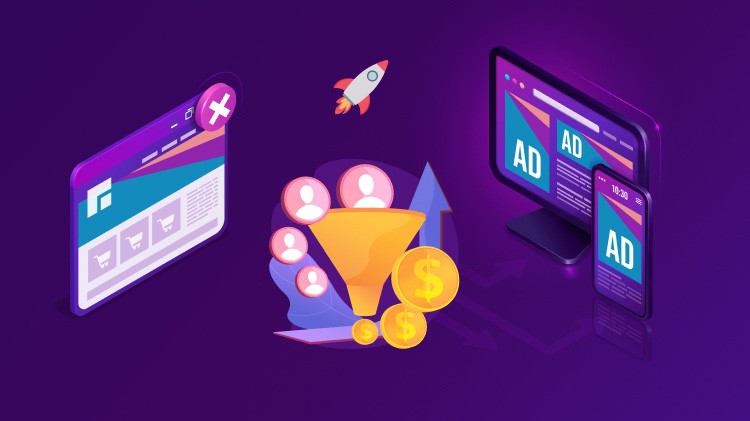
Expertise in Advertising Management Since 2017
Maximize Your Online Visibility and ROI.
99.9% Client Satisfaction
In a constantly evolving digital world, effective online presence is crucial. Our online advertising management service is designed to maximize your visibility and return on investment, helping you achieve your business goals quickly and efficiently.
Why Choose Our Online Advertising Management Service?
Transparent Tracking and Reporting:
Receive detailed reports on your campaign performance, with clear insights and recommendations for continuous improvement.
Our Expertise in Ads Management
At DigitalMarPro, we master the art of ad management to maximize the ROI of your online campaigns. Our approach is rooted in thorough analysis and relevant keyword research, allowing us to create and optimize impactful ads. With advanced targeting, we ensure that your ads reach the most relevant audience. We effectively manage your budget to maximize every advertising investment. annonces percutantes. Grâce à un ciblage avancé, nous nous assurons que vos publicités atteignent le public le plus pertinent. Nous gérons efficacement votre budget pour maximiser chaque investissement publicitaire.
- Keyword Analysis and Research
- Ad Creation and Optimization
- Advanced Targeting
- Budget Management
- Performance Monitoring and Analysis
- A/B Testing
- Ongoing Support
Google Ads Management
Our Google Ads management service is designed to maximize your return on investment and increase your online visibility. We offer a strategic and personalized approach for each campaign, ensuring that your ads reach the right audiences at the right time. Here's what our advertising management service includes:
- Keyword Analysis and Research
- Ad Creation and Optimization
- Advanced Targeting
- Budget Management
- Performance Monitoring and Analysis
- A/B Testing
- Ongoing Support
Facebook Ads :
We leverage Facebook's precise targeting capabilities to increase your brand awareness and conversions.
Instagram Ads :
We use captivating visuals to engage an active audience on one of the most popular social media platforms.
YouTube Ads :
We enable you to capture the attention of your potential customers with engaging video ads on YouTube.
TikoTok Ads :
We engage your audience in real-time with ads on TikTok.
How We Work
Initial Consultation
We start with a consultation to understand your business goals and specific needs.
Planning and Strategy
We develop a detailed advertising strategy based on your goals and budget.
Implementation
We implement the strategy and launch your advertising campaigns.
Continuous Optimization
We monitor performance and continuously optimize campaigns for better results.
Advertising Videos Creation
We offer three levels of service for creating advertising videos to meet your specific needs and budget. Our creation process includes an initial consultation to understand your goals and target audience, followed by pre-production to storyboard and plan visual and audio elements. Next, we move to production, where we shoot necessary footage and record voiceovers if needed. Finally, in post-production, we add animations and special effects, integrate background music, and make revisions based on your feedback before delivering the final video in the required formats.
Advertising Poster Creation
Our advertising poster creation services provide impactful visual solutions to promote your business on physical media. Whether for posters, flyers, or banners, we create eye-catching designs that capture attention and effectively communicate your message.
- Creation of unique designs tailored to your brand.
- High-quality printing.
- Availability of various formats and sizes.
- Texts and images optimized to capture attention.
- Recommendations on best placements and practices.
Quality, Results, and Exceptional Service Guaranteed

Advertising Management Methodology

Solutions for Every Objective

Expert Advice, Optimal Results

Discover our advertising management services, where we specialize in maximizing the effectiveness of your advertising campaigns. From Google Ads to social media advertising, our team of experts delivers tangible results for your business. With strategic targeting, impactful ad creatives, and meticulous campaign optimization, we ensure that your advertising budget is wisely invested. Whether it's to increase brand awareness, drive traffic to your website, or improve conversions, we help you navigate the world of online advertising for unparalleled success.
Propel Your Brand with Our Premium Advertising Management SolutionsPremium Ads Management: Quality Solutions
At our advertising agency DigitalMarPro, we are committed to providing top-tier advertising management services that exceed your expectations. Our team of seasoned experts brings rich industry experience and deep knowledge to every project, ensuring that your campaigns are meticulously crafted to achieve optimal results. We prioritize quality throughout our management process, from strategic planning and precise targeting to creating impactful ads and ongoing optimization. With a commitment to transparency, accountability, and client satisfaction, we strive to deliver significant return on investment for your advertising spend. Partner with us and experience the difference that a quality-focused approach can make in elevating your brand's online presence and success in the digital landscape.
Transform your e-commerce business with our strategic shopping advertising management services. We specialize in maximizing visibility and performance of your products on platforms like Google Shopping. From optimizing product feeds and implementing precise targeting to creating compelling ads, we ensure your products stand out to potential customers. With our data-driven approach and continuous optimization, we drive qualified traffic to your online store, resulting in increased sales and revenue. Partner with us to harness the full potential of shopping ads and propel your e-commerce success.
Boost Your Online Visibility with Our Advanced Advertising Management
Looking to enhance your online visibility through effective and high-performing advertising campaigns? Discover our advertising management services, specially designed to meet your specific needs and propel your business towards digital success. Whether you're aiming to increase brand awareness, attract more traffic to your website, or improve conversions, our team of online advertising management experts is here to support you.
FAQ
Ads Management
Explore the common questions about our advertising management services below to better understand how we tailor our strategies, track performance, manage budgets, and optimize campaigns for maximum impact and optimal return on investment (ROI):
Online advertising management involves planning, creating, optimizing, and tracking advertising campaigns on the Internet. It aims to promote products or services using advertising platforms such as Google Ads, Facebook Ads, and others to reach a targeted audience and generate conversions.
Planning:
- Define the objectives of the advertising campaign.
- Identify the target audience and their online behaviors.
- Establish a realistic advertising budget.
Creation:
- Research relevant keywords to target audiences.
- Design attractive ads with catchy headlines and compelling descriptions.
- Create impactful visuals that capture users' attention.
Optimization:
- Track ad performance in real-time.
- Analyze data to identify trends and optimization opportunities.
- Adjust bids, keywords, and targeting settings to improve results.
Tracking:
- Use analytical tools to monitor conversions and user interactions.
- Regularly review performance reports to evaluate campaign effectiveness.
- Adapt the strategy based on results to maximize return on investment (ROI).
Google Ads operates on an auction model where advertisers bid on keywords relevant to their business. When a user performs a search that matches these keywords, relevant ads are displayed at the top of the search results. Advertisers only pay when their ad is clicked, known as cost-per-click (CPC).
Keyword Research:
- Conduct thorough research on keywords relevant to your business and target audience.
- Use tools like Google Keyword Planner to identify the most searched keywords in your industry.
Ad Creation:
- Design attractive and relevant ads that match the targeted keywords.
- Include clear calls to action to encourage users to click on your ads.
Bid Setting:
- Determine the maximum amount you are willing to pay for each click on your ads (CPC bid).
- Use automated or manual bidding strategies based on your advertising objectives.
Targeting and Settings:
- Select the geographic locations where you want your ads to be displayed.
- Set specific time ranges during which you want your ads to run.
- Refine your targeting based on the interests, online behaviors, and demographics of your target audience.
Tracking and Optimization:
- Use Google Ads tracking tools to monitor your ad performance in real-time.
- Analyze data to identify the best-performing keywords, most effective ads, and necessary adjustments.
- Regularly optimize your campaigns by adjusting bids, adding new keywords, and testing new ads to improve results.
Online advertising offers precise targeting, real-time performance measurement, global reach, budget flexibility, and measurable return on investment (ROI). Unlike traditional advertising, it allows advertisers to directly reach their target audience, optimize campaigns based on performance, and achieve tangible results.
Precise Targeting:
- Online advertising enables specific targeting of audiences based on demographic, geographic, behavioral, and interest criteria.
Measurability of Results:
- The performance of online advertising campaigns can be measured in real-time using various key performance indicators (KPIs).
Flexibility and Adjustability:
- Online ads can be quickly modified and adjusted based on performance data and user feedback.
Controllable Costs:
- Online advertising costs can be controlled and adjusted according to budgets and business objectives.
Global Reach:
- Online advertising offers global reach, allowing businesses to target audiences worldwide, 24/7.
Interactive Engagement:
- Online ad formats often provide opportunities for interactive engagement with users, such as clicks, likes, shares, etc.
Content Personalization:
- Online ads can be personalized based on user preferences and behavior, offering a more relevant advertising experience.
Precise ROI Tracking:
- The results of online advertising campaigns can be accurately tracked and attributed, making it easier to evaluate return on investment (ROI).
24/7 Accessibility:
- Online ads are accessible at any time, allowing users to interact with advertising content at their convenience.
Facilitated Experimentation:
- Online advertising allows advertisers to experiment with different formats, channels, and strategies to find what works best for their business.
By leveraging these advantages, businesses can maximize the effectiveness of their online advertising campaigns and achieve positive results for their brand and products.
To optimize a Google Ads campaign, it’s essential to conduct thorough keyword research, create relevant and attractive ads, optimize landing pages, set strategic bids, use ad extensions, track performance, and make regular adjustments based on results.
Keyword Review:
- Review keyword performance and remove those generating low traffic or poor conversions.
- Add new relevant keywords and test their performance.
Ad Optimization:
- Test different ad variations to identify which generate the best click-through rates (CTR) and most conversions.
- Use catchy headlines, compelling descriptions, and strong calls to action.
Landing Page Improvement:
- Ensure the landing page is relevant to the ad and provides an optimal user experience.
- Optimize page load speed and mobile-friendliness.
Bid Adjustment:
- Monitor bids to ensure you meet your cost per acquisition (CPA) or return on investment (ROI) goals.
- Use automated or manual bidding strategies based on campaign objectives.
Audience Targeting:
- Refine audience targeting based on demographic data, interests, and online behavior.
- Create personalized ads for different audience segments.
Use of Ad Extensions:
- Add ad extensions such as sitelinks, customer reviews, and location information to enhance ad visibility and relevance.
Continuous Testing:
- Conduct regular A/B testing to compare different strategies, ads, and landing pages.
- Analyze data and adjust the campaign based on results.
Conversion Tracking:
- Set up conversion tracking to accurately measure campaign results and optimize performance.
- Use clear conversion goals to evaluate campaign success.
Report Analysis:
- Regularly review performance reports to identify trends, optimization opportunities, and areas for improvement.
Strategic Evolution:
- Adapt campaign strategy based on market changes, seasons, or search trends.
By following this checklist and implementing these optimization practices, you can maximize the effectiveness of your Google Ads campaign and achieve better results for your business.
The cost of online advertising management varies based on several factors, including campaign complexity, business goals, industry competition, and the size of the target market. Fees may include the advertising budget itself, as well as agency or consultant management fees.
Advertising Budget:
- Define a realistic advertising budget based on campaign goals and available resources.
Management Fees:
- Consider fees charged by advertising agencies or consultants, which may be based on a percentage of the advertising budget or fixed fees.
Production Costs:
- Take into account costs for creating ads, graphic design, content development, and video production, if applicable.
Tools and Software:
- Assess costs of tools and software necessary for managing advertising campaigns, such as advertising management platforms and analytics tools
Testing and Optimization:
- Allocate resources for A/B testing, ongoing campaign optimization, and strategic adjustments to improve performance.
Variable Costs:
- Factor in variable costs related to advertising auctions, such as cost-per-click (CPC) or cost-per-thousand-impressions (CPM), which can vary based on competition and ad quality.
Other Fees:
- Anticipate other potential fees, such as social media management fees, translation costs for multilingual campaigns, and customer support fees
By carefully examining each aspect of these potential costs, you can develop a realistic and effective advertising budget for your online campaigns.
KPIs for online advertising include click-through rate (CTR), cost per click (CPC), conversion rate, return on ad spend (ROAS), cost per acquisition (CPA), and volume of qualified traffic. These indicators help measure campaign effectiveness and optimize advertising spend accordingly.
Click-Through Rate (CTR):
- Measures the percentage of users who clicked on an ad compared to the total number of people who viewed it.
Cost Per Click (CPC):
- Indicates the average cost paid for each click on an ad. Calculated by dividing the total campaign cost by the number of clicks.
Conversion Rate:
- Measures the percentage of users who completed a desired action after clicking on an ad, such as making a purchase or signing up.
Cost Per Acquisition (CPA):
- Determines the average cost to acquire a new customer or conversion. Calculated by dividing the total campaign cost by the number of conversions.
Return on Ad Spend (ROAS):
- Evaluates the revenue generated compared to advertising costs. Calculated by dividing campaign revenue by total campaign cost, then multiplying by 100 to get a percentage.
Cart Abandonment Rate:
- Measures the percentage of users who add products to their cart but do not complete the purchase. A high rate may indicate usability issues or barriers to purchase.
Bounce Rate:
- Indicates the percentage of users who leave your site after viewing only one page. A high bounce rate may signal a mismatch between the ad and the landing page.
Session Duration:
- Measures the average time users spend on your site after clicking an ad. A longer session duration may indicate engaging and relevant content.
Number of Leads Generated:
- Counts the total number of qualified prospects or contacts generated by the advertising campaign. Crucial for service-oriented or sales-focused businesses.
Volume of Qualified Traffic:
- Measures the total number of qualified visitors directed to your website by the advertising campaign. Qualified traffic consists of individuals with high potential for purchase or conversion.
By following this checklist and carefully monitoring these key performance indicators, you can assess the effectiveness of your online advertising campaigns and make adjustments to maximize results.
The difference between SEO (Search Engine Optimization) and SEM (Search Engine Marketing) lies primarily in their approach, objectives, nature of results, costs, timeframes for results, and strategic focus:
Objectives:
- SEO: Focuses on improving a website's organic (unpaid) ranking in search engine results pages (SERPs) to increase visibility and traffic.
- SEM: Includes SEO but also incorporates paid advertising methods like Google Ads to enhance a website's visibility in search results and generate immediate traffic.
Nature of Results:
- SEO: Results are organic, meaning they appear naturally in search results based on their relevance to the searched keywords.
- SEM: Results are paid and typically displayed at the top or bottom of search results with a label such as "Ad" or "Sponsored."
Cost:
- SEO: Generally less costly over the long term because it doesn't involve direct payments for each click to the website.
- SEM: Involves direct costs as advertisers pay for each click on their ads, often through a bidding model like CPC (Cost Per Click).
Time to Results:
- SEO: Results can take time to manifest as it involves optimizing the website and building authority to achieve higher rankings.
- SEM: Provides immediate results since ads are displayed as soon as the campaign is launched and the advertising budget is active.
Long-Term vs. Short-Term Strategy:
- SEO: Typically considered a long-term strategy aimed at building a sustainable online presence and maintaining high rankings in search engines over time.
- SEM: Often used as a short-term strategy to quickly generate traffic and conversions, especially for new websites or temporary promotions.
In summary, while both SEO and SEM aim to increase a website's visibility on search engines, they differ in their approach, cost structure, immediacy of results, and strategic focus. Choosing the right mix of SEO and SEM depends on your business goals, budget, and timeline for achieving results in the competitive landscape of online marketing.
The success of an online advertising campaign can be measured using various performance indicators such as the number of clicks, conversion rate, return on investment, and cost per acquisition. Advertising platform analytics tools provide detailed data on campaign performance, enabling identification of strengths and weaknesses and adjustments as needed.
Goal Definition:
- Clarify campaign goals such as number of conversions, generated revenue, click-through rate, etc.
Selection of Key Performance Indicators (KPIs):
- Choose relevant KPIs based on campaign goals, such as conversion rate, return on investment (ROI), cost per acquisition (CPA), etc.
Setting Up Tracking Tools:
- Implement tracking tools like Google Analytics to measure campaign performance and track user interactions with the website.
Conversion Tracking:
- Set up conversion tracking to measure desired user actions such as purchases, sign-ups, downloads, etc.
Report Analysis:
- Regularly review performance reports to evaluate campaign results, identify trends, and discover optimization opportunities.
Comparison with Objectives:
- Compare achieved results with initially defined goals to assess campaign success.
Cost Analysis:
- Calculate return on investment (ROI) by comparing generated revenue with campaign costs.
Strategic Adjustments:
- Use insights gained to make strategic adjustments to the campaign, such as bid optimization, audience targeting, ad modifications, etc.
Long-Term Performance Evaluation:
- Examine campaign performance over an extended period to evaluate its long-term impact on business objectives.
Retrospective and Learning:
- Conduct a campaign retrospective to identify lessons learned and best practices to integrate into future advertising initiatives.
By following this checklist and thoroughly analyzing campaign performance, you can effectively measure the success of your online advertising efforts and optimize your strategies for even better results in the future.
Best practices for creating online advertising include thorough keyword research, using catchy headlines and compelling descriptions, adding clear calls to action, customizing ads for the target audience, and using ad extensions to provide additional information to users.
Keyword Research:
- Conduct thorough research on relevant keywords to target your audience.
- Use keyword research tools to identify the most searched terms in your industry.
Catchy Headlines:
- Create catchy and relevant headlines that immediately grab users' attention.
- Include targeted keywords in headlines to enhance ad relevance.
Compelling Descriptions:
- Write concise yet compelling descriptions that highlight the benefits of your product or service.
- Include a clear and compelling call to action to encourage users to click on the ad.
Use of Attractive Visuals:
- Integrate striking and high-quality visuals into your ads to attract users' attention.
- Ensure visuals are relevant to the ad content and your brand.
Platform Adaptation:
- Optimize ads according to the specificities of each advertising platform, whether it's Google Ads, Facebook Ads, or others.
- Adhere to platform guidelines and recommendations regarding ad formats and sizes.
A/B Testing:
- Conduct A/B tests to compare different ad versions and determine which one yields the best results.
- Test different elements such as headlines, descriptions, visuals, and calls to action.
Personalization:
- Personalize ads based on the behavior and interests of your target audience.
- Use demographic data, interests, and online behavior to tailor ad content.
Continuous Optimization:
- Regularly monitor ad performance and make adjustments based on results.
- Optimize bids, keywords, and targeting to improve ad relevance and effectiveness. Results Analysis:
Analyze performance data to understand what works well and what can be improved.
- Analyze performance data to understand what works well and what can be improved.
- Use the insights gained to refine your advertising strategy and achieve better results in the future.
By following this checklist and implementing these best practices, you can create compelling online ads that engage your target audience and drive positive results for your business.
Online advertising types include search ads, display ads, video ads, social media ads, and shopping ads. The choice of advertising type depends on your business goals, budget, and target audience. A well-planned advertising strategy may include several types of ads to achieve
Paid Search (Search Ads):
- Ads appear in search results based on keywords entered by users.
- Suitable for businesses targeting users actively searching for similar products or services.
Display Ads:
- Graphical ads appear on Google partner websites or advertising networks.
- Ideal for building brand awareness and reaching a wide audience.
Video Ads:
- Video ads are shown before, during, or after videos on platforms like YouTube.
- Perfect for visually presenting products or services in an engaging way.
Social Media Ads:
- Ads are displayed on social media platforms like Facebook, Instagram, LinkedIn, etc.
- Tailored to target specific audiences based on interests, demographics, and online behavior.
Remarketing Ads:
- Ads are shown to users who have previously visited your website or interacted with your brand.
- Useful for bringing back previous visitors and encouraging them to complete a purchase or conversion.
Native Ads:
- Ads are seamlessly integrated into the editorial content of a website.
- Provide a non-intrusive advertising experience and can be well-suited to surrounding content.
Shopping Ads:
- Ads display specific products with details such as price and availability.
- Ideal for e-commerce businesses looking to promote products directly in search results.
Audio Ads:
- Audio ads are played during audio content such as podcasts or music streaming services.
- Suitable for businesses targeting audiences on-the-go or consuming audio content.
By carefully examining the characteristics and goals of each type of online advertising, you can determine which one is best suited for your business and specific marketing objectives.
We understand the importance of transparency and flexibility in pricing. As every business is unique, we offer a range of packages tailored to different needs and budgets.
To get detailed information about our packages and choose the one that best suits your needs, please contact us directly. We'd be happy to discuss your expectations and provide you with the necessary information to make an informed decision.
Importance of Keyword Research
Keyword research is essential for identifying the terms and phrases that users enter into search engines. This allows advertisers to effectively target their audience and optimize their campaigns for optimal results.
- Keyword Research Tools io
- Google Keyword Planner
- SEMrush
- Ahrefs
- io
- Selection of Relevant Keywords
- Choose keywords relevant to your business and offer.
- Look for keywords with high search volume and low competition.
- Use long-tail keywords to target specific audiences.
Catchy Titles
- Use impactful titles to grab users' attention.
- Include relevant keywords in your titles to enhance the relevance of your ads.
- Persuasive Descriptions
- Write convincing descriptions that highlight the benefits of your product or service.
Include a clear call to action to encourage users to take action.
- Powerful Calls to Action
- Use strong calls to action such as "Buy Now," "Sign Up Today," etc.
- Test different calls to action to determine which one works best.
Geographic Targeting
- Set geographic targeting parameters to reach users in regions relevant to your business.
- Use location targeting to exclude irrelevant areas.
- Behavioral Targeting
- Target users based on their online behavior, such as recent purchases or interactions with your website.
- Interest Targeting
- Use interest targeting to reach users likely to be interested in your products or services based on their interests.
Bidding Strategies
- Choose the bidding strategy that best suits your campaign goals, such as target CPA or target ROAS.
- Test different bidding strategies to determine which one works best for your business.
- Bid Adjustments
- Adjust bids based on the performance of keywords, locations, and devices.
- Use bid adjustments to target specific audiences or particular times of the day.
Setting Up Conversion Tracking
- Install the conversion tracking code on your website to measure valuable user actions, such as purchases, sign-ups, and contact inquiries.
- Use conversion tracking tags to track offline interactions, such as phone calls and in-store visits.
- Interpreting Conversion Data
- Analyze conversion data to understand how users interact with your website after clicking on your ads.
- Use this information to optimize your campaigns and maximize the return on investment (ROI) of your advertising spend.
A/B Testing
- Conduct A/B tests to compare different variations of ads, keywords, and campaign settings.
- Analyze the test results to identify the top-performing elements and the best strategies to adopt.
- Performance Monitoring and Analysis
- Regularly monitor your campaign performance using Google Ads reports.
- Identify trends, optimization opportunities, and areas for improvement to adjust your strategy accordingly.
- Strategic Adjustments
- Make strategic adjustments based on data and insights gained from performance analysis.
- Continuously optimize your campaigns to maximize results and achieve your business goals.
Key Performance Indicators (KPI)
- Click-Through Rate (CTR)
- Cost per Click (CPC)
- Conversion Rate
- Return on Investment (ROI)
- Coût par Acquisition (CPA)
- Using Google Ads Reports
- Generate custom reports to monitor your campaign performance and track your goals.
- Use insights from the reports to make informed decisions and optimize your campaigns for optimal results.







